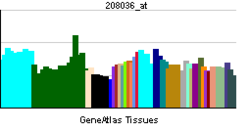- OPN1SW
-
Opsin 1 (cone pigments), short-wave-sensitive Identifiers Symbols OPN1SW; BCP; BOP; CBT External IDs OMIM: 613522 MGI: 99438 HomoloGene: 1291 GeneCards: OPN1SW Gene Gene Ontology Molecular function • receptor activity
• G-protein coupled receptor activity
• photoreceptor activityCellular component • photoreceptor outer segment
• plasma membrane
• integral to plasma membraneBiological process • signal transduction
• visual perception
• phototransduction
• protein-chromophore linkage
• response to stimulusSources: Amigo / QuickGO RNA expression pattern 
More reference expression data Orthologs Species Human Mouse Entrez 611 12057 Ensembl ENSG00000128617 ENSMUSG00000058831 UniProt P03999 P51491 RefSeq (mRNA) NM_001708 NM_007538.3 RefSeq (protein) NP_001699 NP_031564.1 Location (UCSC) Chr 7:
128.41 – 128.42 MbChr 6:
29.33 – 29.33 MbPubMed search [1] [2] Blue-sensitive opsin is a protein that in humans is encoded by the OPN1SW gene.[1][2][3]
See also
References
- ^ Nathans J, Thomas D, Hogness DS (Apr 1986). "Molecular genetics of human color vision: the genes encoding blue, green, and red pigments". Science 232 (4747): 193–202. doi:10.1126/science.2937147. PMID 2937147.
- ^ Fitzgibbon J, Appukuttan B, Gayther S, Wells D, Delhanty J, Hunt DM (Feb 1994). "Localisation of the human blue cone pigment gene to chromosome band 7q31.3-32". Hum Genet 93 (1): 79–80. PMID 8270261.
- ^ "Entrez Gene: OPN1SW opsin 1 (cone pigments), short-wave-sensitive (color blindness, tritan)". http://www.ncbi.nlm.nih.gov/sites/entrez?Db=gene&Cmd=ShowDetailView&TermToSearch=611.
Further reading
- Applebury ML, Hargrave PA (1987). "Molecular biology of the visual pigments.". Vision Res. 26 (12): 1881–95. doi:10.1016/0042-6989(86)90115-X. PMID 3303660.
- Swanson WH, Cohen JM (2003). "Color vision.". Ophthalmology clinics of North America 16 (2): 179–203. doi:10.1016/S0896-1549(03)00004-X. PMID 12809157.
- Weitz CJ, Went LN, Nathans J (1992). "Human tritanopia associated with a third amino acid substitution in the blue-sensitive visual pigment". Am. J. Hum. Genet. 51 (2): 444–6. PMC 1682686. PMID 1386496. http://www.pubmedcentral.nih.gov/articlerender.fcgi?tool=pmcentrez&artid=1682686.
- Weitz CJ, Miyake Y, Shinzato K et al. (1992). "Human tritanopia associated with two amino acid substitutions in the blue-sensitive opsin". Am. J. Hum. Genet. 50 (3): 498–507. PMC 1684278. PMID 1531728. http://www.pubmedcentral.nih.gov/articlerender.fcgi?tool=pmcentrez&artid=1684278.
- Oprian DD, Asenjo AB, Lee N, Pelletier SL (1992). "Design, chemical synthesis, and expression of genes for the three human color vision pigments". Biochemistry 30 (48): 11367–72. doi:10.1021/bi00112a002. PMID 1742276.
- Sarkar G, Sommer SS (1989). "Access to a messenger RNA sequence or its protein product is not limited by tissue or species specificity". Science 244 (4902): 331–4. doi:10.1126/science.2565599. PMID 2565599.
- Nathans J, Piantanida TP, Eddy RL et al. (1986). "Molecular genetics of inherited variation in human color vision". Science 232 (4747): 203–10. doi:10.1126/science.3485310. PMID 3485310.
- Shimmin LC, Mai P, Li WH (1997). "Sequences and evolution of human and squirrel monkey blue opsin genes". J. Mol. Evol. 44 (4): 378–82. doi:10.1007/PL00006157. PMID 9089077.
- Scherer SW, Cheung J, MacDonald JR et al. (2003). "Human Chromosome 7: DNA Sequence and Biology". Science 300 (5620): 767–72. doi:10.1126/science.1083423. PMC 2882961. PMID 12690205. http://www.pubmedcentral.nih.gov/articlerender.fcgi?tool=pmcentrez&artid=2882961.
- Gunther KL, Neitz J, Neitz M (2006). "A novel mutation in the short-wavelength-sensitive cone pigment gene associated with a tritan color vision defect". Vis. Neurosci. 23 (3–4): 403–9. doi:10.1017/S0952523806233169. PMID 16961973.
Metabolites and
signaling moleculesOtherBile acid · Cannabinoid (CB1, CB2, GPR (18, 55, 119)) · EBI2 · Estrogen · Free fatty acid (1, 2, 3, 4) · Lactate · Lysophosphatidic acid (1, 2, 3, 4, 5, 6) · Lysophospholipid (1, 2, 3, 4, 5, 6, 7, 8) · Niacin (1, 2) · Oxoglutarate · PAF · Sphingosine-1-phosphate (1, 2, 3, 4, 5) · SuccinatePeptideOtherAnaphylatoxin (C3a, C5a) · Angiotensin (1, 2) · Apelin · Bombesin (BRS3, GRPR, NMBR) · Bradykinin (B1, B2) · Chemokine · Cholecystokinin (A, B) · Endothelin (A, B) · Formyl peptide (1, 2, 3) · FSH · Galanin (1, 2, 3) · GHB receptor · Gonadotropin-releasing hormone (1, 2) · Ghrelin · Kisspeptin · Luteinizing hormone/choriogonadotropin · MAS (1, 1L, D, E, F, G, X1, X2, X3, X4) · Melanocortin (1, 2, 3, 4, 5) · MCHR (1, 2) · Motilin · Opioid (Delta, Kappa, Mu, Nociceptin & Zeta, but not Sigma) · Orexin (1, 2) · Oxytocin · Prokineticin (1, 2) · Prolactin-releasing peptide · Relaxin (1, 2, 3, 4) · Somatostatin (1, 2, 3, 4, 5) · Tachykinin (1, 2, 3) · Thyrotropin · Thyrotropin-releasing hormone · Urotensin-II · Vasopressin (1A, 1B, 2)MiscellaneousGPR (1, 3, 4, 6, 12, 15, 17, 18, 19, 20, 21, 22, 23, 25, 26, 27, 31, 32, 33, 34, 35, 37, 39, 42, 44, 45, 50, 52, 55, 61, 62, 63, 65, 68, 75, 77, 78, 81, 82, 83, 84, 85, 87, 88, 92, 101, 103, 109A, 109B, 119, 120, 132, 135, 137B, 139, 141, 142, 146, 148, 149, 150, 151, 152, 153, 160, 161, 162, 171, 173, 174, 176, 177, 182, 183)OtherClass B: Secretin like OtherBrain-specific angiogenesis inhibitor (1, 2, 3) · Cadherin (1, 2, 3) · Calcitonin · CALCRL · CD97 · Corticotropin-releasing hormone (1, 2) · EMR (1, 2, 3) · Glucagon (GR, GIPR, GLP1R, GLP2R) · Growth hormone releasing hormone · PACAPR1 · GPR · Latrophilin (1, 2, 3, ELTD1) · Methuselah-like proteins · Parathyroid hormone (1, 2) · Secretin · Vasoactive intestinal peptide (1, 2)Class C: Metabotropic
glutamate / pheromoneOtherClass F:
Frizzled / SmoothenedFrizzledSmoothenedB trdu: iter (nrpl/grfl/cytl/horl), csrc (lgic, enzr, gprc, igsr, intg, nrpr/grfr/cytr), itra (adap, gbpr, mapk), calc, lipd; path (hedp, wntp, tgfp+mapp, notp, jakp, fsap, hipp, tlrp) Opsin (retinylidene protein) Crystallin Other M: EYE
anat(g/a/p)/phys/devp/prot
noco/cong/tumr, epon
proc, drug(S1A/1E/1F/1L)
Categories:- Human proteins
- Transmembrane receptor stubs
- G protein coupled receptors
Wikimedia Foundation. 2010.
